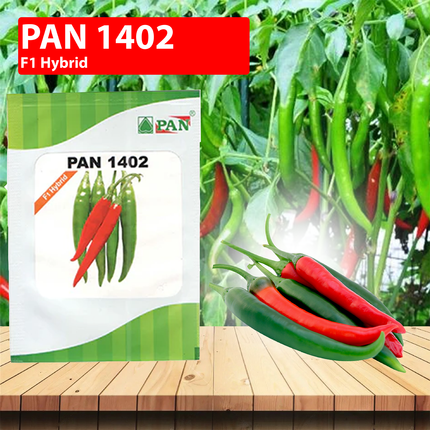Description
PAN 1402 F1 Hybrid Chilli seeds are a popular choice for both home gardeners and farmers looking for a high-yielding, disease-resistant variety.
Key Features:
-
Sowing time: September-February
-
Duration: 40-45 days
-
Fruit length: 6-7 cm
-
Fruit diameter: 1-1.2 cm
-
Pungency: High
-
Seed rate: 100 g/acre
-
Special features: LCV tolerance, high pungency, suitable for both green and dry use, easy harvesting
Benefits:
-
High yields: You can expect to harvest a large amount of chillies from a single plant.
-
Disease resistance: These chillies are resistant to many common diseases, such as leaf spot and wilt.
-
Adaptability: They can be grown in a variety of climates and soil types.
-
Versatility: You can use them fresh, dried, or powdered in a variety of dishes.
-
Easy to grow: Even beginner gardeners can successfully grow PAN 1402 F1 Hybrid Chilli seeds.
Land Preparation:
-
Number of ploughings: 2-3 ploughings are generally recommended to achieve a fine tilth.
-
Depth of ploughing: The first ploughing should be deep (18-20 cm) to break the hardpan and improve drainage. Subsequent ploughings can be shallower (10-12 cm).
-
Timing: Ploughing is best done during the summer months (April-May) to allow the soil to dry and aerate.
-
Moisture content: Ideally, the soil should have moderate moisture content during ploughing. Avoid ploughing when the soil is too wet or dry.
-
After ploughing, remove all weeds, stones, and other debris from the field. This will prevent competition for resources and facilitate smooth land leveling.
-
Incorporate well-decomposed farmyard manure (FYM) or compost at 15-20 tons per acre at the time of final ploughing. This improves soil fertility, water holding capacity, and soil structure.
-
Incorporate well-decomposed farmyard manure (FYM) or compost at 15-20 tons per acre at the time of final ploughing. This improves soil fertility, water holding capacity, and soil structure.
-
Apply a basal dose of fertilizers based on soil test recommendations. A general recommendation is 40 kg nitrogen, 60 kg phosphorus, and 40 kg potassium per acre.
Sowing
-
Sow of PAN 1402 F1 Hybrid Chilli seeds in a well-drained seedbed with fertile soil.
-
Sow seeds thinly, about 2-3 cm apart.
-
Cover the seeds lightly with soil.
-
Water the seedbed regularly and keep it moist.
-
PAN 1402 F1 Hybrid Chilli Seedlings should emerge in 7-10 days.
Transplanting:
-
Transplant Chilli seedlings to the field when they are 4-5 weeks old and have 4-5 true leaves.
-
Harden off seedlings for a week before transplanting by gradually exposing them to outdoor conditions.
-
Prepare the field by tilling, levelling, and making planting holes.
-
Space the plants 45-60 cm apart in rows that are 60-75 cm apart.
-
Make sure the roots are not bent when planting.
-
Water the plants thoroughly after transplanting.
Harvesting:
-
Chillies are ready for harvest when they reach full color and size.
-
Ripe PAN 1402 F1 Hybrid Chilli
-
Use sharp scissors or pruners to harvest the chillies.
-
Cut the stem about 1 cm above the fruit.
-
Harvest chillies regularly, as this will encourage further fruiting.
Storage:
-
Fresh PAN 1402 F1 Hybrid Chilli can be stored in the refrigerator for up to 2 weeks.
-
PAN 1402 F1 Hybrid Chilli stored in refrigerator
-
Wash chillies gently before storing them.
-
Place PAN 1402 F1 Hybrid Chillis in a plastic bag and remove as much air as possible.
-
Alternatively, chillies can be dried or frozen for longer storage.
Drying of PAN 1402 F1 Hybrid Chilli:
-
Wash chillies and remove stems.
-
Slice chillies into thin strips or leave them whole.
-
Spread chillies on a clean drying rack or on trays in a well-ventilated area.
-
Drying chillies
-
Turn chillies regularly to ensure even drying.
-
Chillies are dry when they are brittle and break easily.
